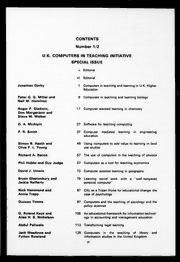
Computers & Education 1992: Vol 19 Table of Contents PDF
Preview Computers & Education 1992: Vol 19 Table of Contents
CONTENTS Number 1/2 U.K. COMPUTERS IN TEACHING INITIATIVE SPECIAL ISSUE Editorial Editorial Jonathan Darby Computers in teaching and learning in U.K. Higher Education Peter G. G. Miller and Computers in teaching and learning biology Neil M. Hamilton Roger P. Gladwin, Computer-assisted learning in chemistry Don Margerison and Steve M. Walker D. A. McAlpin Software for teaching computing P. R. Smith Computer mediated learning in engineering education Simon B. Heath and Using computers to add value to learning in land Clive P. L. Young use studies Richard A. Bacon The use of computers in the teaching of physics Phil Hobbs and Guy Judge Computers as a tool for teaching economics David J. Unwin Computer assisted learning in geography Bryan Glastonbury and Learning social work with a ‘well-tempered Jackie Rafferty personal computer” Nick Hammond and CAL as a Trojan Horse for educational change: the Annie Trapp case of psychology Duncan Timms Computers and the teaching of sociology and the policy sciences G. Roland Kaye and An educational framework for information technol- Aiisa H. S. Nicholson ogy in accounting and management education Abdul Paliwala Transforming legal learning Jack Meadows and Computers in the teaching of library and Fytton Rowland information studies in the United Kingdom Pam Bishop, Mike Beilby and Computer-based learning in mathematics and Adrian Bowman statistics Malcolm Waterfield Computers in teaching medicine and Susan Furber P. Perkins, D. A. Spaeth Computers and the teaching of history and archae- and R. H. Trainor ology in higher education June Thompson and CALL for all Graham Chesters Anthony Pople Computer music and computer-based musicology M. Deegan, S. Lee Computing in textual studies and C. Mullings Jonathan Darby The future of computers in teaching and learning Announcement Number 3 Charles Crook 199 Young children’s skill in using a mouse to control a graphical computer interface Lawrence A. Klein 209 Integration of the microcomputer into the changing Michael J. Cerullo accounting curriculum: an analysis of recent and M. Virginia Cerullo findings Roy Martin Richards and An evolutionary change in the Information Systems Clive C. Sanford curriculum at the University of North Texas Michael Wood Using spreadsheets to make statistics easier for novices G. P. Nikishkov and FEMTR—finite element educational code Yu. G. Nikishkov Michael T. Tang and The use of oral communication approaches to Charles W. McNichols enhance the instruction environment for MIS classes Philip Swann Computer Assisted Language Learning for English as a Foreign Language K. V. Ramani Graphics based instructional software for decision tree analysis using Bayesian methodology Shirley A. Becker, Integrating systems development theory and Gene G. McGuire practice in an Information Systems curriculum and Larry R. Medsker Vilson J. Leffa Reading with an electronic glossary IV Albert C. Tuijnman and Determinants of computer use in lower secondary Alfons C. A. Ten Brummel- schools in Japan and the United States huis Manfred Lang Computer readiness of teachers E. C. Anderssen and The acquisition of operating systems concepts by C. P. H. Myburgh computer science students Number 4 Iissaka Ndekugri 321 A real life simulator for construction | site and Peter Lansley management Antonio Gisolfi, 329 A fuzzy approach to student modeling Antonina Dattolo and Walter Balzano Christopher R. Wolfe Using an authoring system to facilitate student- centered discovery oriented learning Marie-Michele Boulet Designing and developing an intelligent advisor system for transfer tasks in music Kazimierz Kowalski Expert system shells in student advising Nasrollah Ahadiat A study of work values of computer education in accounting Ton de Jong, Joost van Andel, Computer assisted learning in higher education in Mark Leiblum and The Netherlands: a review of findings Marcel Mirande John Murnane To iterate or to recurse? Book Reviews
